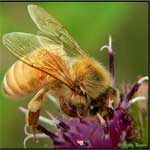![]() “Royal Pains: Why Queen Honeybees Are Living Shorter, Less Productive Lives,” by By Francie Diep
“Royal Pains: Why Queen Honeybees Are Living Shorter, Less Productive Lives,” by By Francie Diep
What’s killing the bees? If you’ve been watching the news, you might answer: “Colony collapse disorder.” Yet after the winter of 2011-2012, beekeepers only attributed 8 percent of their wintertime honeybee-hive losses to colony collapse disorder. … In fact, some entomologists say colony collapse disorder is no longer a major problem. After a spike in incidents in 2006, when the condition was first described, cases dwindled. American honeybee colonies are still dying at an average rate of 30 percent every year, but most hives succumb to the same problems that have plagued beekeepers since 1990 or even 1890: bees running out of honey to eat over the winter, the blood-sucking Varroa mite, and unhealthy queens. … “I think we have known for a long time that miticides can adversely affect queens and kill drone sperm,” says Dennis vanEngelsdorp, an entomologist at the University of Maryland who was one of the first to identify colony collapse disorder. “It’s like chemotherapy. They know it’s bad, but it’s a lot better than the alternative.” Read the full article at Scientific American.
Pesticides Used to Help Save Honeybees
September 25, 2013

